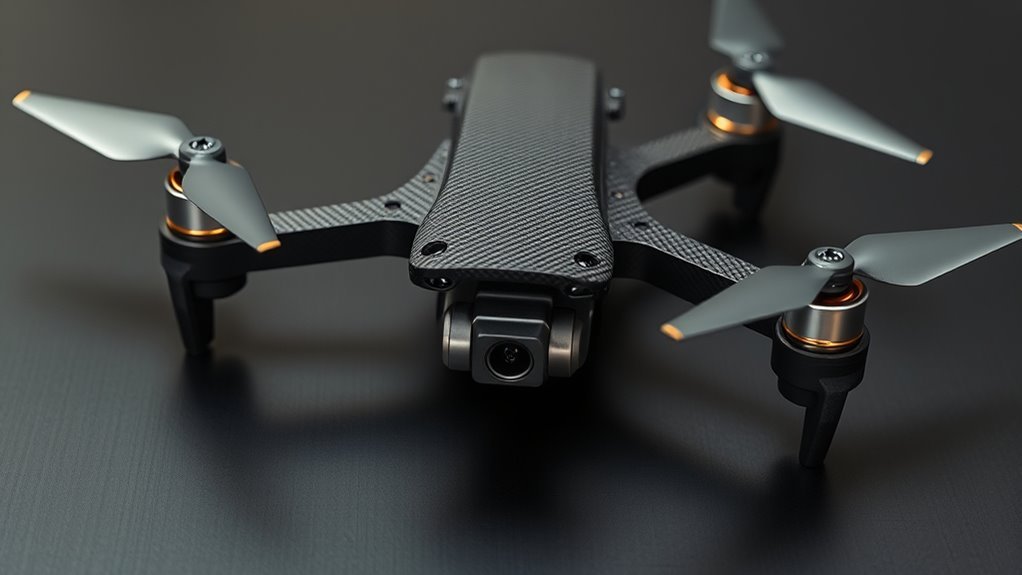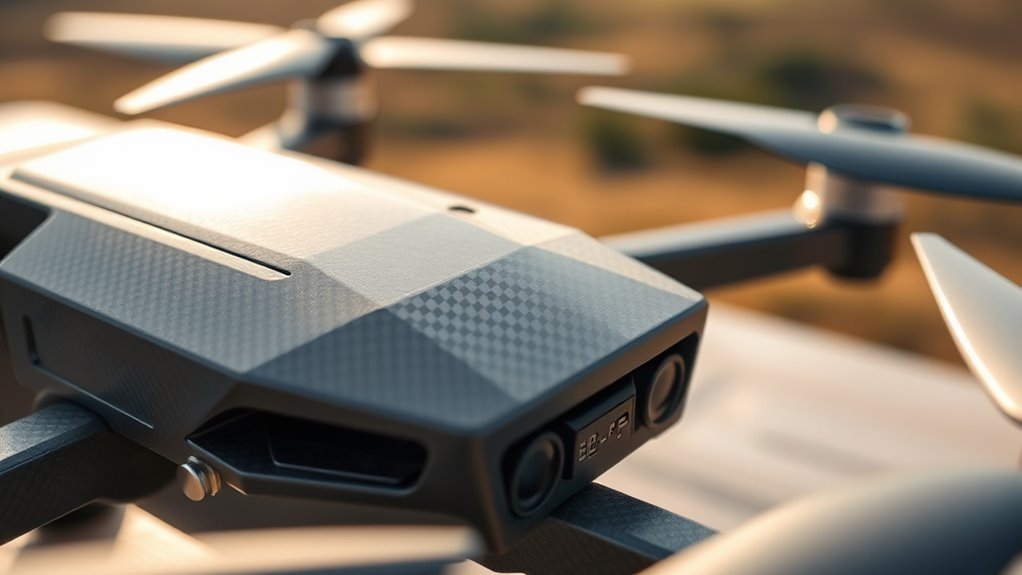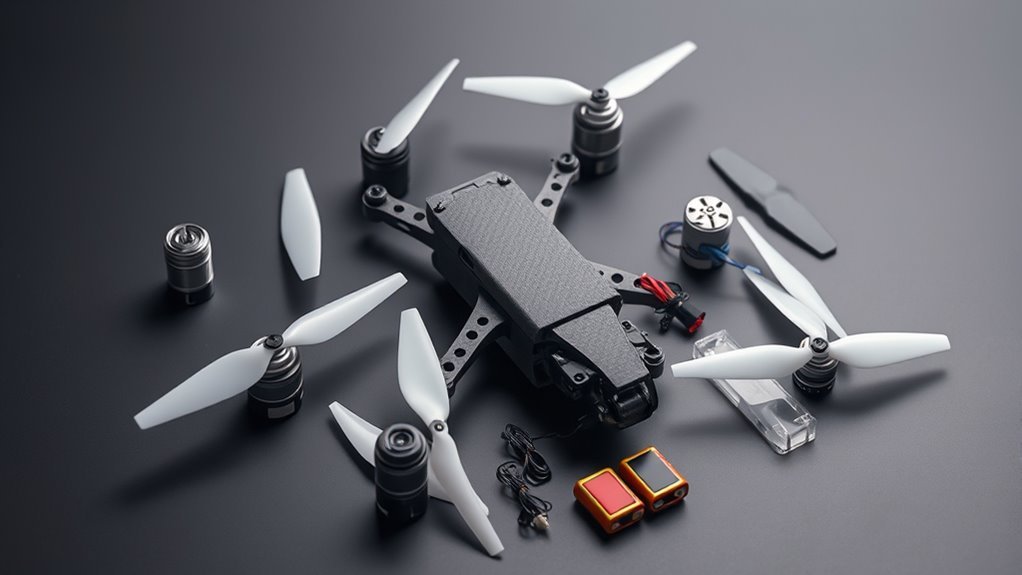Drones are made from a range of materials to optimize performance and efficiency. Carbon fiber offers exceptional strength and lightweight properties, while aluminum provides durability and corrosion resistance. Magnesium alloys enhance flight performance with low density and high strength. Plastic offers versatility and cost-effectiveness, and wood presents a traditional, aesthetic option with sustainability benefits. Advanced composite materials are revolutionizing drone construction, integrating the best attributes of various materials. There’s much more to explore in material applications and advancements.
Carbon Fiber: Strength and Lightweight Properties

Carbon fiber is a revolutionary material in drone construction, offering an exceptional combination of strength and lightweight properties that are essential for ideal performance. You’ll find that carbon fiber applications extend beyond just the frame; components like arms and landing gear benefit greatly from its robust characteristics. One of the primary carbon fiber advantages is its high tensile strength, allowing drones to withstand stress without adding unnecessary weight. This lightweight nature enhances flight efficiency, enabling longer flight times and improved maneuverability. With reduced drag and increased durability, carbon fiber not only extends the lifespan of your drone but also provides the freedom to explore various environments. Ultimately, choosing carbon fiber could elevate your drone’s capabilities, making it a critical choice in advanced aerial design.
Plastic: Versatility and Cost Efficiency

When evaluating materials for drones, plastic stands out due to its lightweight structural benefits, which enhance overall performance. Its cost-effective manufacturing process allows for mass production without sacrificing quality. Additionally, the impact resistance properties of plastic make it an ideal choice for ensuring durability in various operating conditions. Moreover, durable materials contribute to the overall reliability and performance of drones, ensuring they can withstand various environmental challenges. The integration of advanced sensors further enhances the drone’s ability to maintain stability during flight, making plastic an even more valuable material choice.
Lightweight Structural Benefits
The use of plastic in drone construction offers significant lightweight structural benefits, primarily due to its versatility and cost efficiency. By implementing plastic, you achieve substantial weight reduction, allowing drones to operate more effectively. This weight reduction directly enhances aerodynamic efficiency, enabling longer flight times and improved maneuverability.
Plastics can be molded into complex shapes, optimizing designs that traditional materials may struggle to achieve. This versatility not only supports diverse applications but also facilitates innovative configurations, adapting to different operational needs. In addition, the lower density of plastics compared to metals contributes to an overall lighter structure, ensuring that drones maintain their agility and responsiveness in various environments. Embracing plastic in drone design reveals potential that aligns with your quest for greater freedom in aerial exploration.
Cost-Effective Manufacturing Process
Building on the lightweight structural benefits of plastics, their cost-effective manufacturing process further enhances their appeal in drone construction. By utilizing advanced manufacturing innovations, such as injection molding and 3D printing, you can greatly reduce production costs and time. These methods allow for rapid prototyping and mass production, providing flexibility in design while maintaining affordability. Additionally, the integration of sustainable practices, like recycling plastic materials, not only lowers costs but also minimizes environmental impact. As you explore options for your drone design, consider how these manufacturing efficiencies can empower you to create high-performance drones that align with both budgetary constraints and ecological responsibility. This approach opens up new avenues for innovation in the ever-evolving drone industry.
Impact Resistance Properties
Although many materials can be utilized in drone construction, plastics stand out for their exceptional impact resistance properties, which contribute considerably to overall performance and durability. When it comes to impact resistance, you’ll find plastics offer:
- Lightweight Strength: Their low density allows for easier flight without sacrificing durability.
- Cost Efficiency: Plastics are often less expensive than metals while meeting impact resistance standards.
- Versatile Applications: Different types of plastics can be tailored to meet specific impact resistance testing requirements.
Aluminum: Durability and Heat Resistance

When considering materials for drone construction, aluminum stands out due to its lightweight structural integrity, which enhances flight efficiency. Its exceptional corrosion resistance properties guarantee longevity and reliability in various environmental conditions. These factors make aluminum a prime choice for resilient drone designs.
Lightweight Structural Integrity
As drones increasingly demand materials that balance strength with weight, aluminum emerges as a leading choice due to its remarkable durability and heat resistance. When you consider aluminum for your drone’s aerodynamic design, you’ll appreciate its lightweight structural integrity. Here are three key benefits:
- Strength-to-Weight Ratio: Aluminum provides exceptional strength without adding unnecessary weight, enhancing flight efficiency.
- Thermal Conductivity: Its ability to dissipate heat protects critical components, maintaining peak performance.
- Versatile Fabrication: Aluminum can be easily shaped and welded, allowing for precise material selection that aligns with design specifications.
Corrosion Resistance Properties
While selecting materials for drone construction, it’s essential to take into account corrosion resistance, particularly with aluminum, which excels in this area. Aluminum naturally forms a protective oxide layer, enhancing its durability against various environmental factors like moisture and salt. This property considerably reduces the risk of corrosion, ensuring your drone maintains its structural integrity over time. When considering the operational environment, the choice of aluminum can be a game-changer, especially in harsh conditions where exposure to corrosive elements is likely. Additionally, aluminum’s heat resistance complements its corrosion resistance, allowing your drone to perform efficiently without succumbing to degradation. Ultimately, prioritizing aluminum for its corrosion resistance contributes to the longevity and reliability of your drone, giving you the freedom to explore without concern.
Magnesium Alloys: Lightweight With High Strength
Magnesium alloys offer an exceptional combination of low density and high strength, making them ideal for drone applications where weight reduction is essential. By utilizing magnesium properties, manufacturers can create drones that are not only lightweight but also robust. Here are three key advantages of using magnesium alloys in drone design:
- Weight Efficiency: Magnesium’s low density allows for significant weight savings, enhancing flight performance.
- High Strength: Despite being lightweight, magnesium alloys provide impressive tensile strength, ensuring structural integrity during operation.
- Corrosion Resistance: Many magnesium alloys exhibit excellent resistance to environmental factors, increasing the longevity of drones in various applications.
Incorporating these alloy applications can lead to advanced designs, giving you the freedom to explore new possibilities in drone technology.
Wood: a Traditional Approach With Unique Benefits
In the quest for lightweight materials, wood emerges as a traditional yet innovative choice in drone design. Its unique properties stem from exceptional wood craftsmanship, ensuring strength while maintaining a low weight. Unlike synthetic materials, wood offers a natural aesthetic that appeals to many enthusiasts. Furthermore, it’s biodegradable and renewable, aligning with the principles of environmental sustainability. By utilizing responsibly sourced timber, you not only reduce the carbon footprint but also support eco-friendly practices. Wood’s resilience against environmental stressors contributes to durability, making it a viable option for various drone applications. Ultimately, choosing wood allows engineers and hobbyists alike to explore creative designs while embracing a material that reflects both tradition and modern innovation.
Composite Materials: The Future of Drone Construction
As drone technology advances, the incorporation of composite materials is revolutionizing construction methods and performance capabilities. These materials address both sustainability concerns and the demand for high-performance designs. Here are three key benefits of using composites in drone construction:The integration of composite materials in drone technology is transforming construction methods and enhancing performance capabilities.
- Weight Reduction: Composites are lighter than metals, enhancing flight efficiency and battery life.
- Durability: They resist corrosion and fatigue, ensuring longevity and reducing maintenance costs.
- Design Flexibility: Composites allow for intricate shapes, enabling future innovations in aerodynamics and functionality.
Frequently Asked Questions
How Do Weather Conditions Affect Drone Material Performance?
Weather conditions greatly influence drone material performance. Temperature effects can cause expansion or contraction, while humidity impact may lead to corrosion or degradation. Understanding these factors guarantees ideal drone functionality and longevity in varying environments.
What Are the Environmental Impacts of Drone Material Production?
You’ll find that the environmental impacts of drone material production hinge on sustainable sourcing practices and material toxicity. Neglecting these factors can lead to pollution and resource depletion, undermining ecological balance and your freedom to explore.
Can Drone Materials Be Recycled or Reused?
You’ll find that drone materials offer various recycling options, contributing to material sustainability. By reusing components, you can greatly reduce waste and enhance the circular economy, aligning with your desire for environmental freedom and responsible consumption.
How Do Material Choices Influence Drone Battery Life?
Material choices shape your drone’s destiny, like a sculptor chipping away at stone. Lightweight materials enhance battery efficiency through weight reduction, extending flight time and offering you the freedom to explore farther and longer.
What Safety Standards Do Drone Materials Need to Meet?
When considering safety standards, you need to verify materials comply with safety regulations through rigorous material testing. This process guarantees durability and reliability, ultimately enhancing your drone’s performance while minimizing risks during operation.

